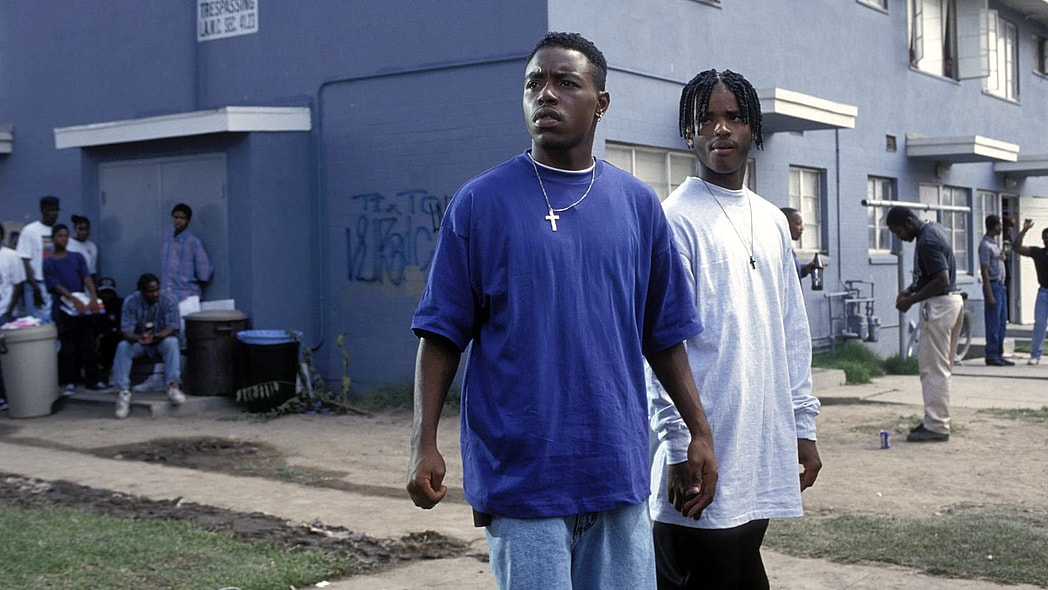Editor’s note: The following article is an op-ed, and the views expressed are the author’s own. Read more opinions on theGrio.
Let me start by making one thing abundantly clear: I believe that “Menace II Society,” the film co-produced and directed by brothers Allen and Albert Hughes, is a classic film. While I didn’t see the film immediately after it was released — I was finishing up my eighth-grade year in middle school in Frankfurt, Germany on May 26, 1993 — when I finally did see it, sometime in the summer of 1993, my 14-year-old brain was convinced that I’d watched the realest movie of all time. I saw “Boyz n the Hood” in theaters in the summer of 1991 as a 12-year-old and even at that age, I remember being moved by the film. But when I saw “Menace,” somehow “Boyz” felt sanitized, maybe even somewhat corny.
I was introduced to Los Angeles by NWA, the hip-hop group composed of Eazy-E, Dr. Dre, Ice Cube, MC Ren and DJ Yella. The tapes that I stole from my older sister as early as 11 years old would set me on a course to becoming a West Coast hip-hop head very early on. And that version of L.A. was violent and unforgiving; there really weren’t happy endings in L.A. as far as I was concerned. So when “Menace” came out and consisted of pure nihilistic violence and mayhem — with a touch of heart, I suppose — I saw the version of L.A. I thought I knew. Carjackings, murder, beatdowns, drivebys, robbery, etc. It was a movie that made all I heard in song real. And I think that was the calling card for the movie; its “realness” was supposed to be its hook. There was no sugar-coating how dangerous life could be and just how quickly one decision could end your life. Oddly, as an outsider, I just knew it was the most honest and realistic representation of South Central L.A.
For years, I would stand 10-toes down on that, too, telling anybody who didn’t know and agreeing with all who agreed with me, “Menace II Society” was the best hood movie ever created. So imagine my surprise when rewatching it recently and feeling like, not only is this not the best hood movie, I’m not even sure it is a good movie at all. Again, like I said, the film is a classic. Larenz Tate’s portrayal of O’Dog is amazing. His turn as the violent, deadly and somewhat insightful teen is iconic. The infamous interrogation room scene with Bill Duke is so compelling that other films and shows spoofed it. If you had any curiosity about what it looked like to actually cook “crack,” there is a scene for you as well. And I haven’t looked at cheeseburgers the same since 1993 because of one of the most famous crackhead scenes ever. Now that I think about it, the film is as much a documentary as it is a movie. In that sense, if it were billed as such — a documentary about life in the concrete playground of Los Angeles — then maybe it’s … good. But as it is, it’s just a series of scenes without any real point other than to demonstrate how easy it is to die on the streets of South Central.
And maybe that was the case for some in 1993; I posted on Facebook that I thought its realness was a little too exaggerated and was told by at least one person who grew up in L.A. in the 1990s that “Menace” was exactly what life was like, that maybe I didn’t like it because the film was too esoteric to be truly appreciated by folks not from there. While I think that’s absolute nonsense — a bunch of violent scenes does not a good movie make — perhaps my lack of connection to that life has made it less impactful on me as a whole, so viewing it with 2023 eyes, all I saw was too much violence and not a representation of real life. Maybe for some, it was.
I think, though, that’s also my struggle with it. Life seemed to suck for everybody onscreen and there was no getting better. The protagonist, Caine (Tyrin Turner), “almost” makes it out but dies trying to save the life of his girlfriend’s son during a drive-by. Caine — doing the voiceover in a style that would influence an entire generation of Tubi movies decades later — realizes that he finally cares if he lives or dies, but now it’s too late. He dies. In a summer when he graduates from high school, Caine is both an accessory to murder, a murderer, a victim of police brutality, a witness to murder, a carjacker, a drug dealer (his longtime vocation) and a victim of murder. I suppose Caine is a representative of all Black men in the sense that literally anything could go wrong but the rays of light seem so few and far between. Like, how does ANYBODY make it out of that world?
In 1993, that felt like “the breaks.” In 2023, it seems exaggerated and extreme to almost parody-like levels. Still a classic film, but not a very good one. I know many people disagree with that; I’ve argued relentlessly with people about this. Being a classic doesn’t make it good, though. To be fair, it is just a movie; but if this movie came out nowadays, it would be a straight-to-Tubi original. I said what I said.
The soundtrack is fire, though.

Panama Jackson is a columnist at theGrio. He writes very Black things and drinks very brown liquors, and is pretty fly for a light guy. His biggest accomplishment to date coincides with his Blackest accomplishment to date in that he received a phone call from Oprah Winfrey after she read one of his pieces (biggest), but he didn’t answer the phone because the caller ID said: “Unknown” (Blackest).
Make sure you check out the Dear Culture podcast every Thursday on theGrio’s Black Podcast Network, where I’ll be hosting some of the Blackest conversations known to humankind. You might not leave the convo with an afro, but you’ll definitely be looking for your Afro Sheen! Listen to Dear Culture on TheGrio’s app; download it here.


